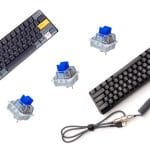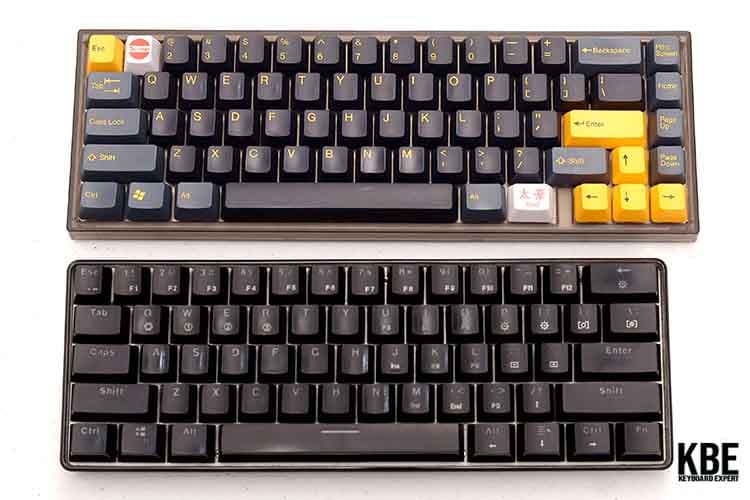
Small form factor keyboards have pretty much taken over the custom and pre-built mechanical keyboard market. Out of all the variants of these keyboards, the two most popular are 60% keyboards and 65% keyboards.
60% keyboards are better for those looking for a smaller footprint keyboard, while 65% keyboards are better for users who require dedicated arrow keys and the three to four extra navigation keys. The functionality of both keyboards is pretty similar, meaning the better keyboard will depend on the user’s personal preference.
Despite their massive popularity, some users are still a bit hesitant in purchasing small form factor keyboards.
Why Are Smaller Keyboards More Popular

Smaller keyboards have pretty much been dominating the market for a couple of years now. It is pretty rare to see high-end keyboards, both in the prebuilt and custom market, to feature a full-sized layout. To explain how these small form factor keyboards overtook full-sized keyboards, let us start by talking about TKL keyboards.
The shift in the dynamics of the keyboard market has been gradually happening for years now. It all started with TKL keyboards. (tenkeyless keyboard). This type of keyboard was initially introduced as a low-cost alternative to full-size keyboards.
However, both gamers and regular consumers found that the smaller TKL keyboard had more benefits compared to the traditional 104 full-sized layout. It allowed their hands to be positioned closer to each other and allowed gamers to make wide mouse movements without hitting the keyboard.
But things didn’t end there. Custom keyboard and prebuilt keyboard manufacturers started introducing smaller form factor keyboards sometime in late 2017 or early 2018. Users initially thought that these smaller keyboards were too impractical since they sacrificed essential keys such as the arrow keys and the delete key.
However, after mainstream brands such as Ducky introduced 60% keyboards in their lineup, every manufacturer started making their own version of the 60% keyboard. Eventually, these keyboards became incredibly popular for users who travel with their keyboards, as well as gamers who required lots of room for their mouse hand.
Since then, other small form factor keyboards and variants of the 60% keyboard have come into the market. One of the variants of the 60% keyboard is the 65% keyboard. It was a modified version that introduced several key improvements to the 60% design.
There have also been even smaller form factor keyboards that are more of novelty items than practical tools for gaming and work. With all the rapid advancements in the mechanical keyboard market, there will undoubtedly be even more unique layouts and form factors that will be coming in the future.
Summary of 60% Keyboards

Now that we’ve gone through why small form factor keyboards are popular let us discuss the two most common small factor layouts in more detail. We will be starting off with 60% keyboards.
Here are the things that you will be getting with a 60% form factor keyboard. Most 60% keyboards have a total number of 61 keys. They are considerably smaller than a TKL keyboard and sacrifices some physical keys in order to achieve this small form factor.
There are a number of reasons why consumers choose 60% keyboards. The first thing is their small and light form factor. 60% keyboards are very easy to carry around. This means that you can easily bring them to your workplace or in competitive LAN events.
Even 60% keyboards that have an aluminum chassis and brass weight are still considerably lighter than larger custom keyboards. In addition, there is plenty of variety in the 60% keyboard market.
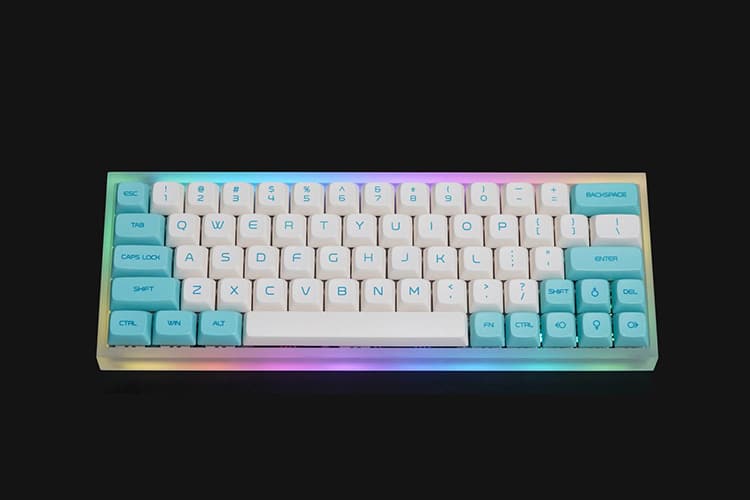
There are wireless 60% keyboards as well as specialized keyboards with custom gaming switches for faster actuation. There are also custom layouts that allow 60% keyboards to incorporate arrow keys.
Of course, adding these keys means that further modification is required. For 60% keyboards that have arrow keys, some keys such as the right shift key are usually compromised. Other keys, such as the “?” keys, are often transferred to other parts of the keyboard.
In terms of case options, most 60% keyboards are compatible with a wide array of cases. The DZ60 PCB from KBDFans, for instance, is compatible with anything from Tofu cases to third-party cases from other brands.
In terms of gaming, 60% keyboards are unbeatable. Out of all the keyboard options available, they provide the most room for wide mouse movements. You can use these keyboards without angling them since it is highly unlikely for you to hit the side of your keyboard case.
Despite all the good points of 60% keyboards, there are still a number of downsides that you have to consider. One of the major cons of 60% keyboards is the fact that they are missing a number of essential physical keys. You can still access them via different layers. However, you will need to train your muscle memory in order to access them.
The good news is that most 60% keyboards allow you to reprogram and choose how you want to access your layers. This will still require some time and effort but is certainly doable
Pros of 60% Keyboards
- Small, Light, and Portable
- Flexible in terms of layout
- Good Variety
- Great for Gaming (Especially for FPS titles)
Cons of 60% Keyboards
- Missing Essential Physical Keys
- Requires an Adjustment Period
Popular 60% Custom and Prebuilt Keyboards
- KBDFans Tofu60
- Ducky One 2 Mini
- Epomaker GK61X/Skyloong GK61 (All GK61 variants)
- Cannonkeys Brutal 60
- Cannonkeys Bakeneko
- Royal Kludge RK61
Summary of 65% Keyboards
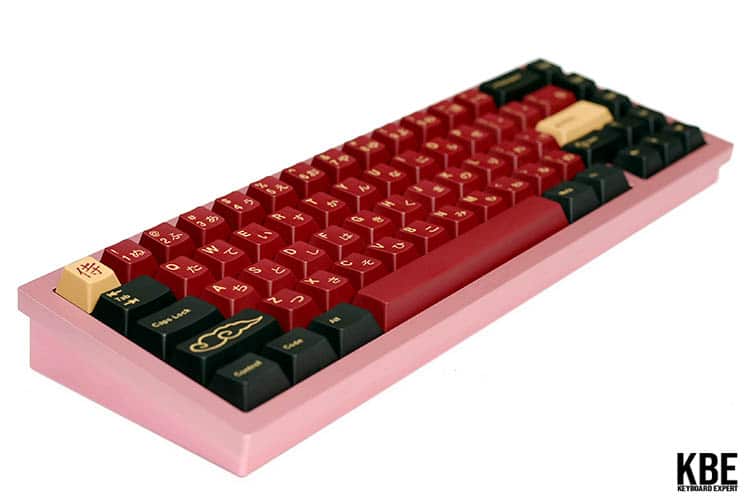
65% keyboards are considered to be a modified version of the 60% form factor. Most of their features are very similar. The only difference is that 65% keyboards have additional keys that help achieve a more complete keyboard experience.
Most 65% keyboards feature 68 keys, meaning they have 6 more keys compared to 60% keyboards. This may not mean a lot for those who have never tried small form factor keyboards. However, these extra keys make 65% keyboards more usable for those who are used to TKL keyboards.
With 65% keyboards, you are finally getting access to dedicated arrow keys and essential keys such as the delete key. You also get two to three extra keys that you can assign to custom macros or pretty much anything you want.
Also, unlike 60% keyboards, 65% keyboards do not utilize an odd layout to achieve its small form factor. The only change that has been made is that the right shift is now smaller (1.75U). This usually isn’t a problem since most keycap sets include this extra key.
You get all of these while still getting the benefits of a 60% keyboard. 65% keyboards are still light and portable. They are only slightly longer than 60% keyboards but are generally not heavier or bulkier.
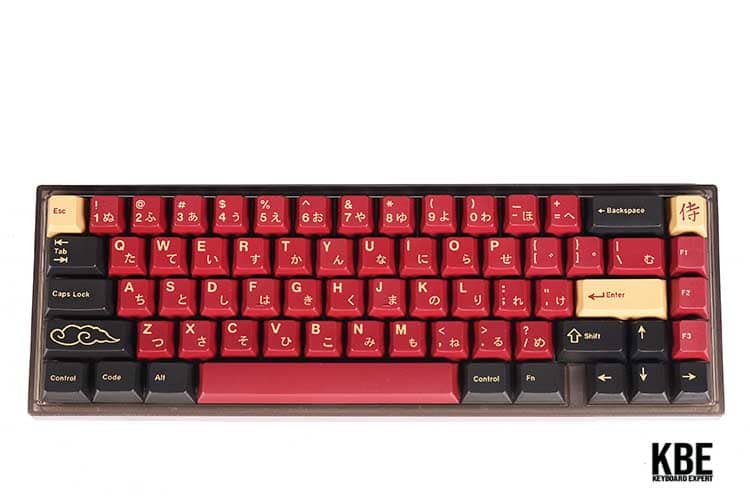
There is also a good variety of 65% keyboards in the market since most big brands have adopted this design. And, of course, 65% keyboards are very good choices for gaming since they still provide ample space for wide mouse swings.
But with that said, 65% still do not fix some of the shortcomings of 65% keyboards. They still do not have F-keys and other keys that may be essential for professionals. This means that you will still have to access them via layers, which some may not be a fan of.
Also, most 65% case designs are proprietary. Unlike 60% keyboards, you cannot just drop 65% PCBs in a brand new case without encountering problems. Everything from the right arrow blocker to the USB placement is different with 65% keyboards. So if you are planning on buying an entry-level 65% keyboard with the hopes of upgrading to an aluminum case, then you are out of luck.
And lastly, users have to note that since 65% keyboards are slightly longer than 60% keyboards, your mouse may hit the edge of your keyboard. This is certainly something that you can train yourself to avoid. However, it may bother some gamers, especially those who are already used to 60% keyboards.
Pros of 65% Keyboards
- Only Slightly Larger Than 60% Keyboards
- Has Most of the Essential Keys Missing From 60% Keyboards
- All the Benefits of 60% Keyboards
Cons of 65% Keyboards
- Have Similar Downsides to 60% Keyboards
- Limited in Terms of Third-Party Case Options
Popular 65% Custom and Prebuilt Keyboards
- Ducky One 2 SF
- Cannonkeys Savage65
- KBDFans Tofu65
- KBDFans KBD67 (Mk2, Mk3, Lite)
- Epomaker GK64X (All GK64 variants)
- Novelkeys NK65 Entry Edition
60% and 65% Keycap Compatibility
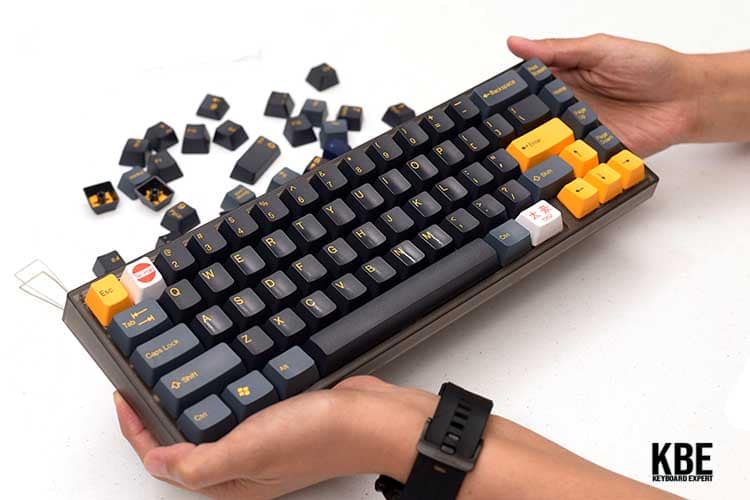
One thing to take note of when purchasing 60% and 65% keyboards is the keycap compatibility. Depending on which model you buy, some 60% and 65% keyboards bring slight deviations to the standard layout.
When buying these kinds of keyboards, it is important to avoid buying 104 key sets since those are made specifically for 104 Full-sized keyboards. They do not have the extra keys that these keyboards need.
In terms of what key sets to buy, you just have to make sure that they have a 1.75U right shift and extra 1U keys. The 1.75U right shift is used by almost all 65% keyboards, as well as some 60% keyboards with arrow keys. The extra 1U keys will be useful for 60% and 65% keyboards that utilize 1U modifiers.
Which is the Better Keyboard?
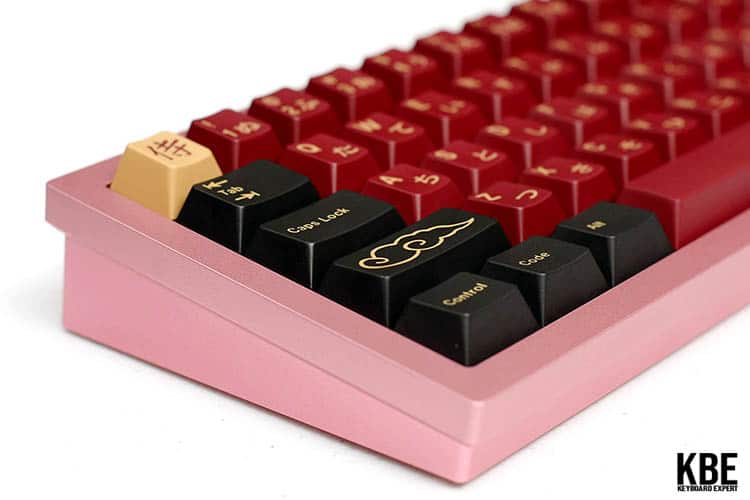
The superior keyboard boils down to which fulfill your personal needs better. If you are someone who is new to mechanical keyboards and wishes to try alternate layouts and different case materials, then 60% keyboards would be a better fit. Also, if you are a low DPI gamer who is looking for the most mouse room possible, then 60% are the clear winner,
However, if you are someone who focuses more on productivity and less on gaming, then the extra keys on 65% keyboards will be handy. Also, if you are already set on the design and material choice used for the case of your keyboard, then 65% will suit you better.
But with that said, there is one more thing that we wish to discuss. What if you are interested in a specific keyboard, but it is not available in your desired form factor? For example, you are interested in a 60% keyboard. However, only the 65% version is in stock. Should you jump to that layout, or should you consider something else?
Unless you are someone who wishes to experiment on different layouts, most enthusiasts would suggest waiting for your desired keyboard to be in stock or choosing something else with the same form factor. This is because if you are already set on a 65% keyboard, then compromising on a smaller layout may potentially hurt your workflow.
Likewise, going with the slightly larger 65% keyboard may not benefit your workflow, especially if you do not need the extra keys. And again, gamers can potentially encounter problems with the slightly larger case of 65% form factors.
So overall, we highly recommend going with the keyboard that best works for your needs. But if you have the time and budget, it is certainly worth exploring both options.

The KBE team is dedicated to sharing our knowledge and creating useful resources about computer keyboards. This article was written as a team collaboration, combining our knowledge and years of experience using, building and modding keyboards. Meet the team here.


